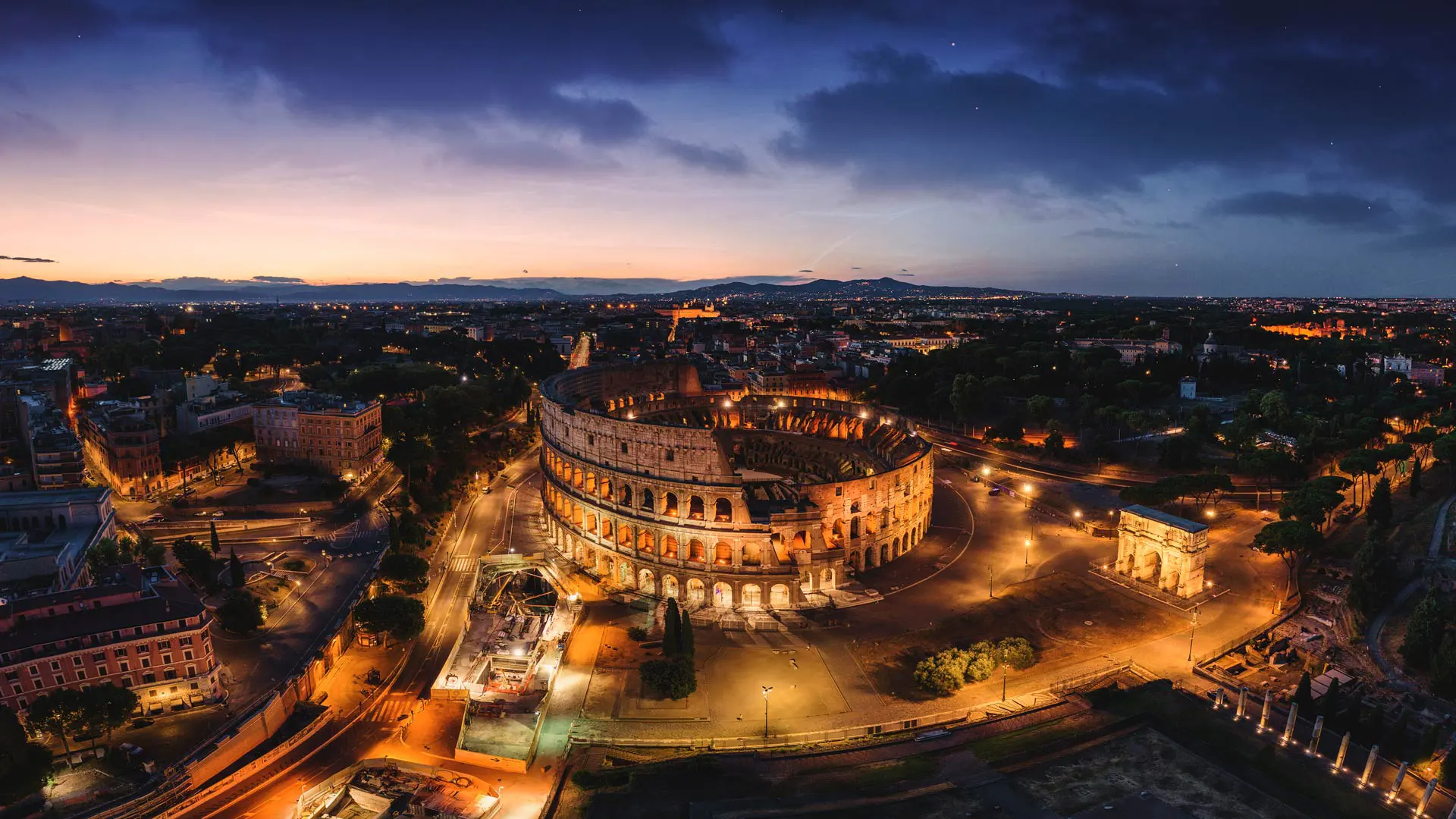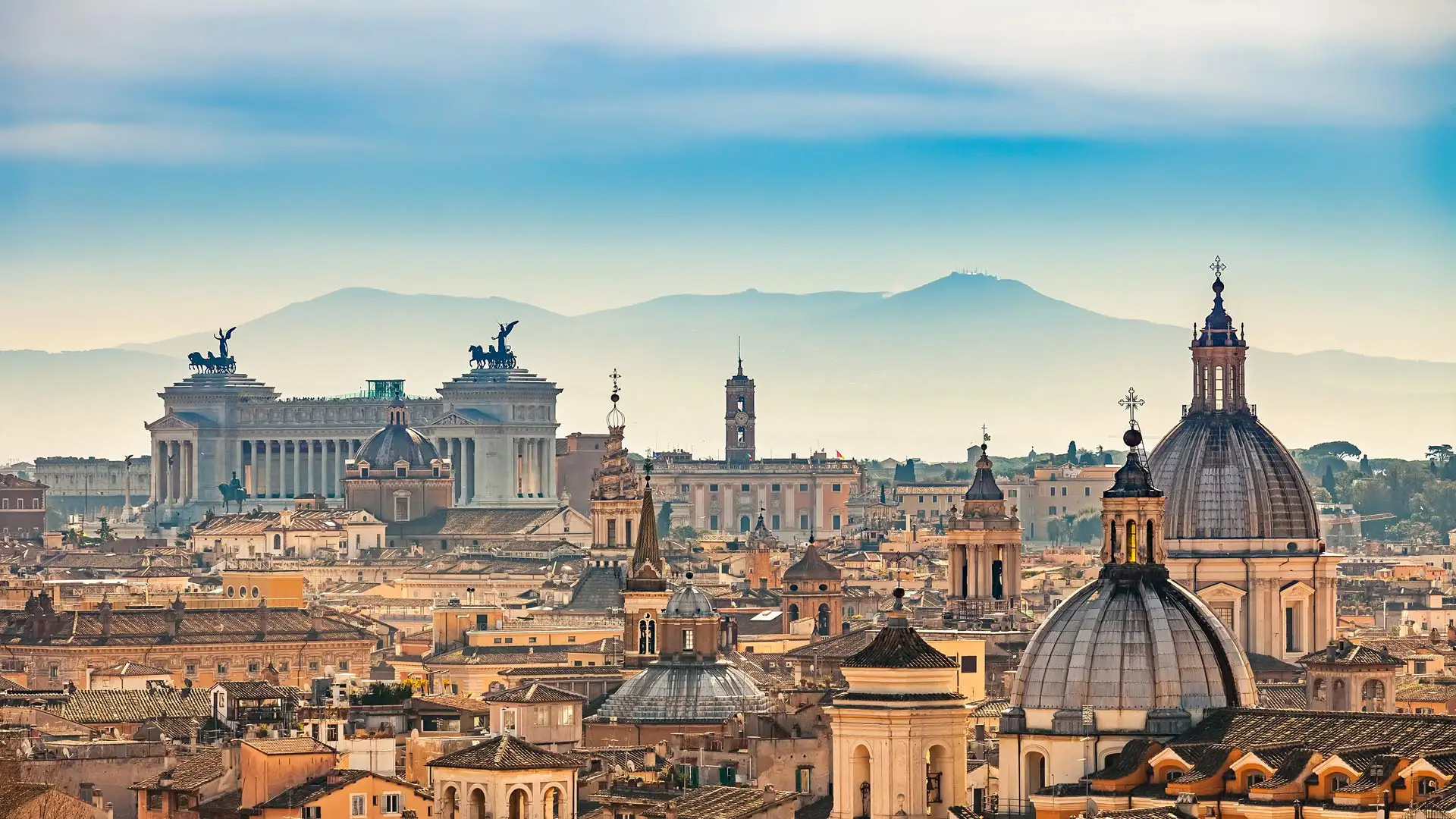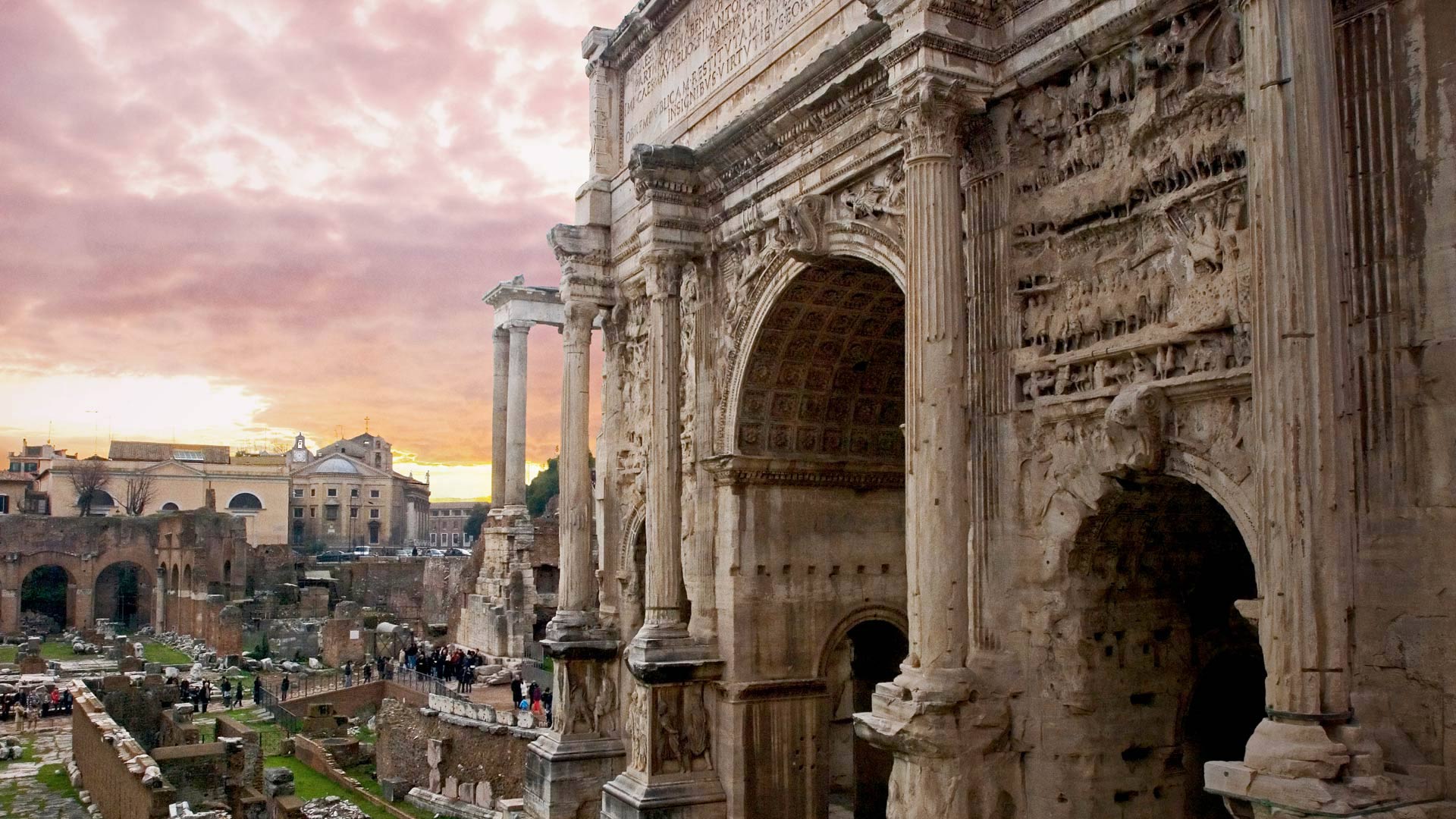斗兽场鸟瞰图,罗马,意大利 Aerial view of the Colosseum, Rome, Italy (© Nico De Pasquale Photography/Getty Images)
斗兽场鸟瞰图,罗马,意大利 Aerial view of the Colosseum, Rome, Italy (© Nico De Pasquale Photography/Getty Images)
条条大路通罗马 All roads lead to Rome
斗兽场,罗马,意大利
觉得现代体育赛事已经足够精彩了吗?在古罗马时代,观众们坐在斗兽场中目睹的表演要激烈得多。这座宏伟的圆形露天竞技场由罗马皇帝韦斯帕先于公元72年下令建造,其子提图斯于公元80年完工。与早期依山而建、借助地形支撑的剧场不同,罗马斗兽场完全独立矗立,是一座自成体系的建筑奇迹。斗兽场由石块与混凝土建成,拱门与穹顶结构支撑着可容纳多达5万名观众的竞技场。角斗士的搏斗、异国野兽的展示,甚至模拟海战,都令观众热血沸腾地下的升降机与暗门让场景转换瞬息万变,充满戏剧张力。
进入中世纪后,斗兽场被赋予了新的用途:曾一度被改作教堂,后来又成为堡垒。几个世纪以来,它经受了雷击、地震与污染的破坏。建筑中大量的石灰华与大理石被重新利用,修建宫殿、防御工事,甚至教堂。这种做法被称为“拆卸再利用”, 它让斗兽场的碎片真正融入了罗马这座不断演变的城市。直到19世纪,人们才开始对其进行系统的保护。如今,罗马斗兽场作为受保护的世界文化遗产,每年吸引近 700 万名游客,依然是意大利最具象征意义的地标之一,见证着古罗马的荣耀与永恒。
Colosseum, Rome, Italy
Think modern sports are dramatic? Ancient Romans had front-row seats to spectacles far more intense inside the Colosseum. Commissioned by the Flavian emperor Vespasian in 72 CE and finished by his son Titus in 80 CE, this amphitheater broke tradition with its predecessors that were built into hillsides for natural support. Instead, the Colosseum was a fully free-standing architectural giant. Crafted from stone and concrete, its arches and vaults supported an arena that could host up to 50,000 spectators. Gladiators, exotic animals, and even staged sea battles thrilled the crowds, while hidden elevators and trapdoors created sudden, dramatic appearances.
During the Middle Ages, the Colosseum found new purposes: first as a church, later as a fortress. Over the centuries, it endured damage from lightning strikes, earthquakes, and pollution. Much of its marble and travertine was also reused in palaces, fortifications, and even churches—a practice known as 'spolia,' which quite literally wove pieces of the structure into the evolving city of Rome. It wasn't until the 19th century that serious preservation began. Today, recognized as a protected monument and welcoming nearly 7 million visitors annually, the Colosseum remains one of Italy's most iconic landmarks.
梵蒂冈城与圣彼得大教堂,罗马,意大利 Vatican City with Saint Peter's Basilica (© RudyBalasko/Getty Images)
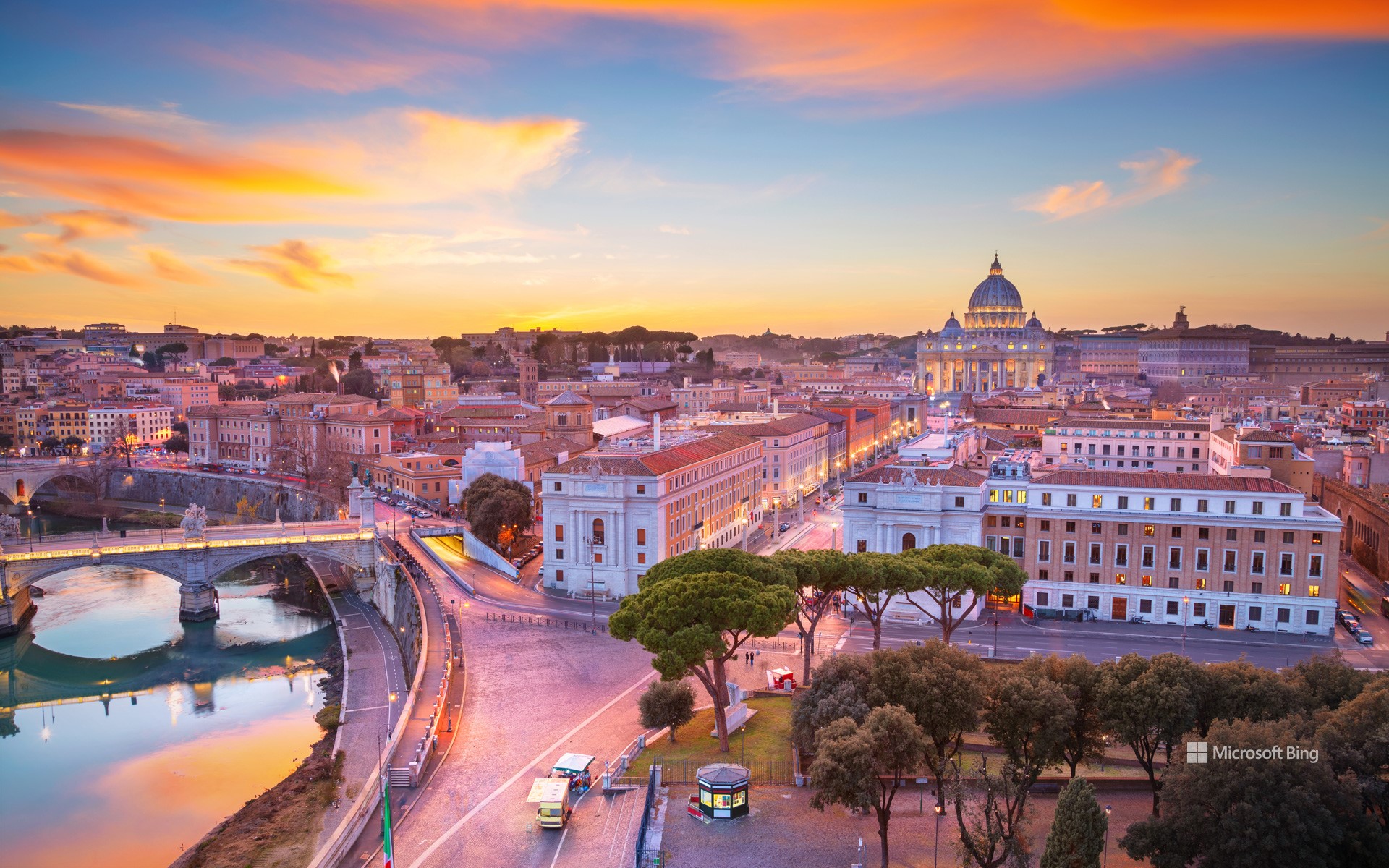
梵蒂冈城与圣彼得大教堂,罗马,意大利 Vatican City with Saint Peter's Basilica (© RudyBalasko/Getty Images)
城中之国 A country within a city
梵蒂冈城,罗马,意大利
在意大利罗马市中心,有一个独立的国家:梵蒂冈城国。这个国家仅有 121 英亩,是世界上最小的独立国家,但其影响力却跨越了数个世纪和各大洲。作为教皇的居所和罗马天主教的精神中心,这座城墙环绕的飞地融合了艺术、历史与信仰。梵蒂冈城的核心地标是圣彼得大教堂,这座文艺复兴时期的建筑被普遍认为建于耶稣门徒、第一任罗马主教圣彼得的安葬地之上。今日图片中远景所示即为其雄伟的穹顶,也是世界上最大的教堂之一。大教堂前的圣彼得广场是教皇祝福仪式和宗教聚会的重要场所,每年吸引大量信众前来朝圣。此外,梵蒂冈博物馆与西斯廷礼拜堂也是不可错过的文化遗产,后者天顶画由米开朗基罗绘制,堪称艺术巅峰。尽管面积狭小,梵蒂冈城国却拥有独立的行政体系,包括邮政、电话系统、银行以及货币发行权。它虽非欧盟成员国,却发行专属欧元硬币。
环绕着梵蒂冈城的是罗马这座城市,本身就是一座活着的博物馆,拥有斗兽场、古罗马广场、万神殿等历史地标。在这里,信仰、历史与现代交织,带来一段独特且难忘的体验。
Vatican City with St. Peter's Basilica
In the middle of Rome, Italy, lies an entire country of its own: Vatican City. At just 121 acres, it's the smallest independent nation in the world, yet its reach spans centuries and continents. Home to the pope and the spiritual center of the Roman Catholic Church, this walled enclave is a blend of art, history, and devotion. At its core stands St. Peter's Basilica. Seen in the distance in today's image, this Renaissance masterpiece is built over what is believed to be the tomb of St. Peter, the first bishop of Rome. With its soaring dome dominating the skyline, the basilica is one of the largest churches in the world. Just beyond the basilica lies St. Peter's Square, where thousands gather for papal blessings. The Vatican Museums and the Sistine Chapel, which houses Michelangelo's famed ceiling, are other must-sees. Despite its size, Vatican City has its own postal service, telephone system, and banking system.
罗马广场上的罗马萨图尔诺农神庙,罗马,意大利 The Temple of Saturn in the Roman Forum, Rome, Italy (© Nico De Pasquale Photography/Getty Images)
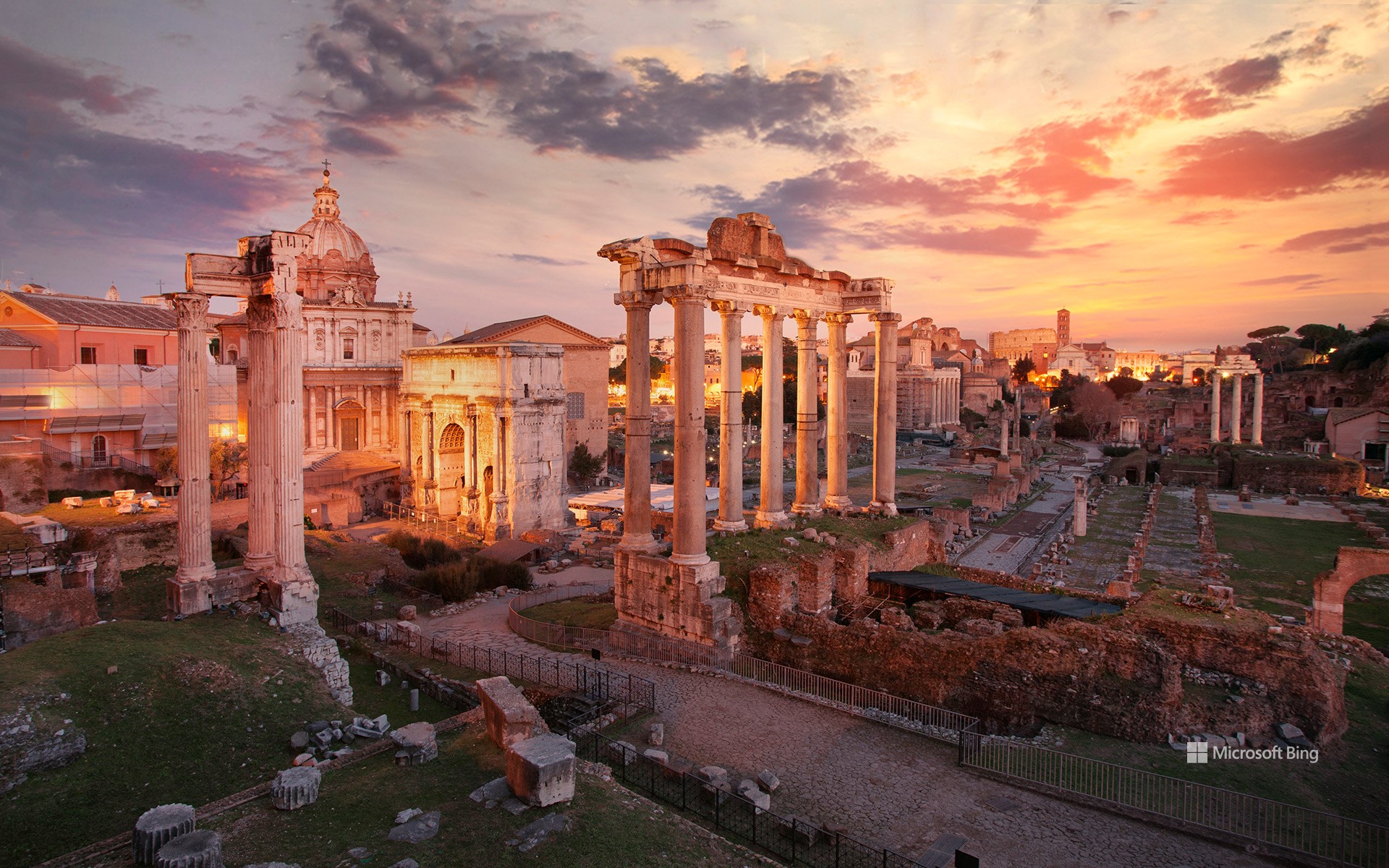
罗马广场上的罗马萨图尔诺农神庙,罗马,意大利 The Temple of Saturn in the Roman Forum, Rome, Italy (© Nico De Pasquale Photography/Getty Images)
“朋友们,罗马人,同胞们…” Friends, Romans, countrymen
罗马萨图尔诺农神庙,意大利
正如莎士比亚在其戏剧《尤利乌斯·凯撒》中所写:“朋友们,罗马人,同胞们,请听我说。”今天是三月十五日,一个深深烙印在罗马历史与传统中的日子。在罗马历法中,“十五日”指的是每月的中旬,通常标志着满月。这一天曾是庆祝节日和公共集会的日子。然而,在公元前 44 年,三月十五日成为政治动荡与背叛的代名词,并引发了罗马共和国覆灭的关键事件。在那个决定性的日子,罗马独裁者凯撒遭到一群元老院成员的刺杀。其中甚至包括他的亲密盟友布鲁图斯。这些密谋者自认为是在拯救共和国,阻止凯撒权力日益膨胀。凯撒在庞贝剧院附近遇刺,这一历史性时刻的影响却回荡在罗马广场,这里曾是罗马政治与社会生活的中心。
如今,漫步在意大利的罗马广场,仍能看到历史的遗迹和曾经辉煌的帝国废墟。其中最重要的遗址之一便是土星神庙,正如今日图片所示。这座罗马广场中最古老、最受尊敬的建筑之一,曾守护着罗马的国库,是凯撒刺客们声称要保护的共和国象征。
Ides of March
As Shakespeare wrote in his play 'Julius Caesar,' 'Friends, Romans, countrymen, lend me your ears.' Today is the Ides of March, a day steeped in Roman history and tradition. The term 'Ides' referred to the midpoint of the month in the Roman calendar, often marking the full moon. It was a time of celebration, with festivals and public gatherings. However, in 44 BCE, the Ides of March became synonymous with political upheaval, betrayal, and an event that would trigger the fall of the Roman Republic. On that fateful day, Julius Caesar, Rome's powerful dictator, was assassinated by a group of senators. The conspirators, including his close ally Brutus, believed they were saving the Republic from Caesar's growing authority. Caesar was attacked near the Theater of Pompey, but the tension of that moment echoed through the Roman Forum—the beating heart of Rome's political and social life.
Strolling through the Forum, in present-day Italy, you can now see the remnants of history and the ruins of a once-mighty empire. Among its many treasures is the Temple of Saturn, pictured here. One of the Forum's oldest and most revered structures, it once guarded the Roman treasury, a stark symbol of the Republic Caesar's assassins claimed to protect.
祖卡里宫,罗马,意大利 Palazzo Zuccari, Rome, Italy (© Photon-Photos/Getty Images)
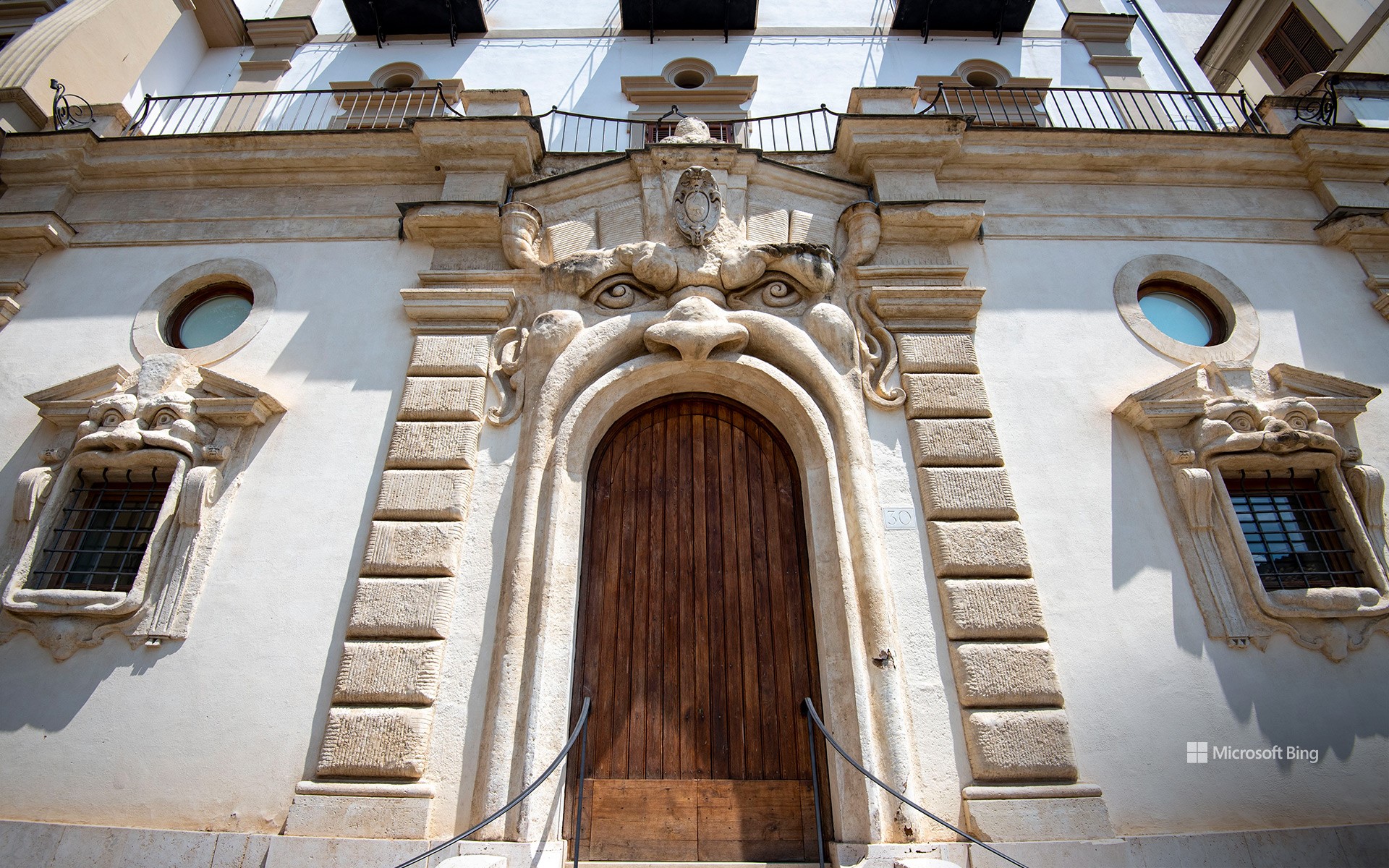
祖卡里宫,罗马,意大利 Palazzo Zuccari, Rome, Italy (© Photon-Photos/Getty Images)
可怕的外墙 Fearsome façade
祖卡里宫,罗马
在罗马西班牙阶梯的顶端,从宏伟的天主教堂下面左转,沿着一条不起眼的小街走下去,有一个惊喜在等着你:一座怪兽之屋。欢迎来到祖卡里宫!这是一座16世纪的宫殿,在它的外墙上,神话似乎栩栩如生,怪诞的面孔吞没了宫殿的门窗。建造这座宫殿的费德里科·祖卡里对怪兽非常精通,他在佛罗伦萨大教堂绘制的《最后的审判》和但丁《地狱篇》的插图满是神话人物。怪兽门最初通向宫殿的花园,因为祖卡里喜欢通过这种方式让客人体验从恐怖入口到美丽花园之间的强烈对比。如今,这扇门通向赫尔奇阿娜图书馆,这是一家专门研究意大利艺术史(从中世纪到现代)的图书馆,自1912年以来一直占据着花园的原址。如果你想在罗马寻找更多的怪嘴,离祖卡里宫不远处就是古罗马面具——“真理之口”,据说它会咬掉任何说谎者的手。
Palazzo Zuccari, Rome
At the top of the Spanish Steps in Rome, take a left underneath the imposing Catholic church. Down an unassuming side street, there's a surprise waiting for you: a house of monsters. Welcome to the Palazzo Zuccari, a 16th-century palace where myths seem to come to life on its façade—grotesque faces swallow up its doors and windows. Federico Zuccari, who built the palace, was well-versed in monsters. His painting of the Last Judgment in Florence Cathedral and his illustrations of Dante's Inferno are replete with mythical beings. The monster door originally led to the palazzo's garden because Zuccari enjoyed making his guests experience the contrast between the scary entrance and the beautiful serenity of the garden. These days, the door leads to the Bibliotheca Hertziana, a library specializing in Italian art history, from the Middle Ages to the modern day, which has occupied the site of the garden since 1912.
If you're looking for more monstrous mouths in Rome, not far from the Palazzo Zuccari is the Bocca della Verità, an ancient Roman mask. According to legend, it will bite off any liar's hand that's placed in its mouth.
从意大利圣天使城堡俯瞰罗马 (© sborisov/Getty Images)
古罗马广场上的萨图尔诺农神庙,意大利罗马 Temple of Saturn in the Roman Forum, Rome, Italy (© Joe Daniel Price/Getty Images)
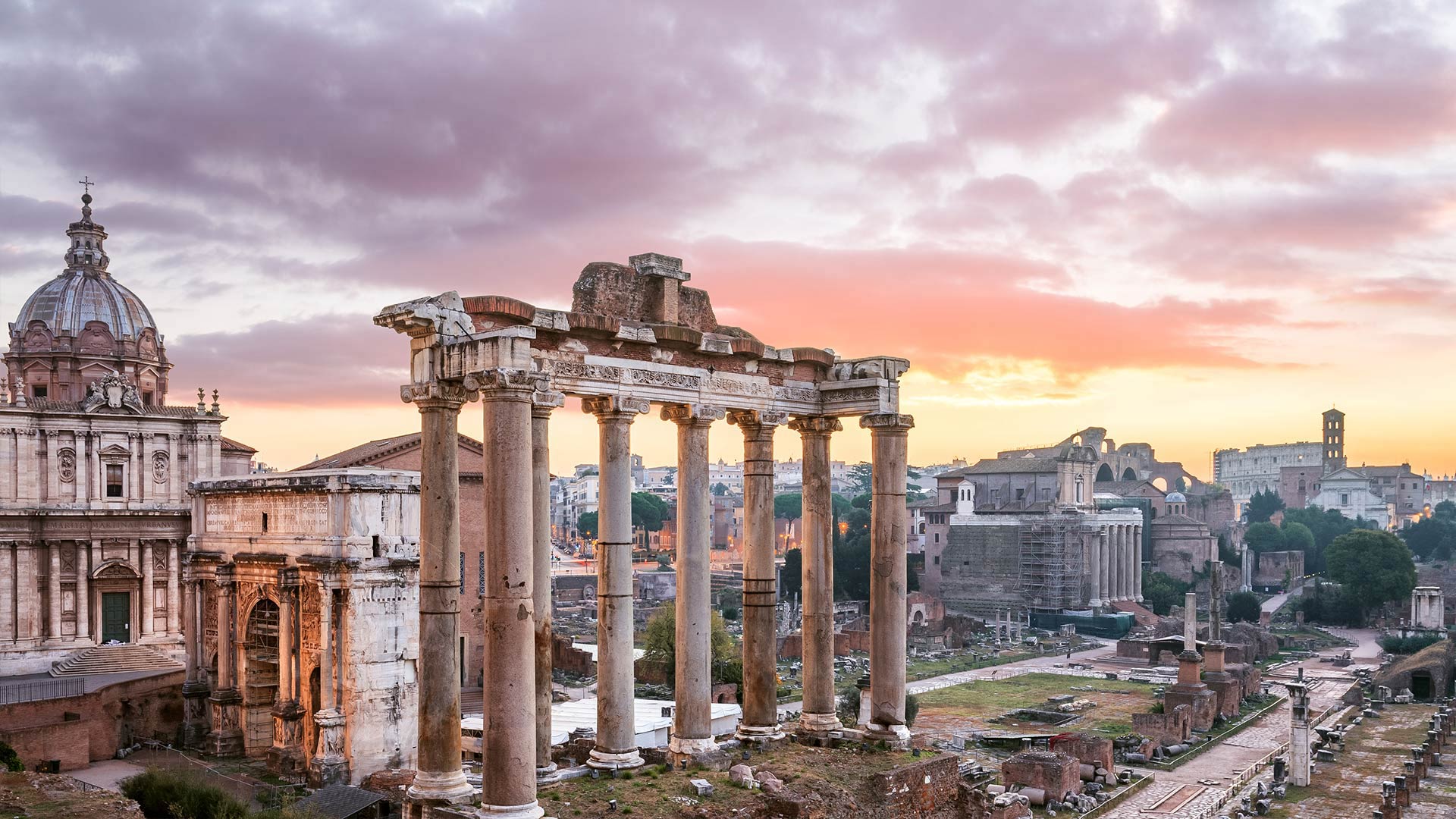
古罗马广场上的萨图尔诺农神庙,意大利罗马 Temple of Saturn in the Roman Forum, Rome, Italy (© Joe Daniel Price/Getty Images)
When in Rome...celebrate Saturnalia
We're looking at the Temple of Saturn, one of the oldest structures of the Forum in Rome. It was here that ancient Romans began their celebrations of Saturnalia, which began on December 17. Both the temple and the festival are dedicated to the agricultural god Saturn, whose reign was associated with a golden age of prosperity and peace. Saturnalia festivities kicked off with a sacrifice at the temple, followed by a public banquet and a week of general merrymaking. Activities included gambling, eating, drinking, and playing music. Businesses and schools closed, and even slaves were free from work and allowed to participate in the merrymaking. Many Saturnalia customs evolved into Christmas traditions, such as gift-giving, decorating homes with wreaths, and drinking spiced wine.
